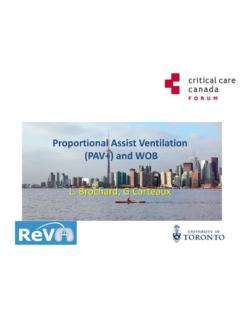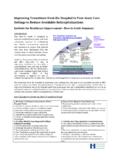Transcription of Transfusion triggers: Going beyond the TRICC study
1 Transfusion triggers : Going beyond the TRICC trial Paul Hebert MD MHSc University of Ottawa Centre for Transfusion Research, Ottawa Health Research Institute and the Ottawa Hospital Historical RBC Transfusion trigger Historical RBC Transfusion trigger Historical RBC Transfusion trigger This condition, owing to the lowered oxygen carrying capacity of the blood interferes with the adequate transportation of oxygen to the tissues. When the concentration of hemoglobin is less than 8-10 gm per 100 cc of whole blood it is wise to give blood Transfusion Lundy. Surg Gynecol Obstet 1954; 74: 1011. study Design study design: Multicentre RCT. Setting: 25 ICUs across Canada study Population: Included Hgb< 90 g/l within 72 hrs and excluded patients with active blood loss (30 g/l decrease or >3 unit Transfusion in 12 hrs). Intervention: 70 g/L vs 100 g/L hemoglobin trigger Outcomes: 30 day all-cause mortality and organ failure Hebert et al. NEJM 321: 151-156, 1999. study Design study design: Multicentre RCT.
2 Setting: 25 ICUs across Canada study Population: Included Hgb< 90 g/l within 72 hrs and excluded patients with active blood loss (30 g/l decrease or >3 unit Transfusion in 12 hrs). Intervention: 70 g/L vs 100 g/L hemoglobin trigger Outcomes: 30 day all-cause mortality and organ failure Hebert et al. NEJM 321: 151-156, 1999. Hemoglobin over time Liberal strategy 120. 110. 100. 90. Hemoglobin (g/L). 80 Restrictive strategy 70. 60. 50. 40 p< 30. 20. 10. 0. 0 5 10 15 20 25 30. Time (Days). Hebert et al. NEJM 321: 151-156, 1999. Hemoglobin over time Liberal strategy units 120. 110. 100. 90. Hemoglobin (g/L). 80 Restrictive strategy 70 units 60. 50. 40 p< 30. 20. 10. 0. 0 5 10 15 20 25 30. Time (Days). Hebert et al. NEJM 321: 151-156, 1999. Survival of all patients over 30 days 100. 90 Restrictive strategy Survival (%). 80. Liberal strategy 70. 60 p= 50. 0 5 10 15 20 25 30. Time (Days). Hebert et al. NEJM 321: 151-156, 1999. Survival of all patients over 30 days 100.
3 90 Restrictive strategy Survival (%). 80. Liberal strategy 70. 60 p= 50. 0 5 10 15 20 25 30. Time (Days). Hebert et al. NEJM 321: 151-156, 1999. RBC Transfusion cause harm? RBC Transfusion cause harm? i ng ? fi n d tru e t o r s r esul ri o u Spu Are findings consistent within study ? Do findings agree with other studies? Are findings generalizable to other patient groups? Observational studies of RBC transfusions Marik and Corwin, CCM 2008;36:2667. Can we trust these studies? Can we trust these studies? Inferences weakened due to: Logic of transfusions always being harmful?? Retrospective studies - limited data collection Minimal adjustment for confounding factors Timing of RBCs unknown Trigger unknown admission hematocrit/nadir hematocrit Main culprit: Confounding by Indication . higher acuity more aggressive care RCTs of Red Cell Transfusion triggers Author Year N Setting Hgb trigger (g/dL). Topley 1956 22 Trauma vs Blair 1986 50 GI Bleed 2 U vs 8U. Fortune 1987 25 Trauma vs Weisel 1992 27 CABG vs Johnson 1992 39 CABG vs Hebert 1995 69 ICU vs Bush 1997 99 Vascular vs Carson 1998 84 Hip Fx vs symptoms Bracey 1999 428 CABG Hebert 1999 838 ICU vs Carson.
4 Trans Med Reviews 2002. RCTs of Red Cell Transfusion triggers Author Year N Setting Hgb trigger (g/dL). Topley 1956 22 Trauma vs Blair 1986 50 GI Bleed 2 U vs 8U. Fortune 1987 25 Trauma vs Weisel 1992 27 CABG vs Johnson 1992 39 CABG vs Hebert 1995 69 ICU vs Bush 1997 99 Vascular vs Carson 1998 84 Hip Fx vs symptoms Bracey 1999 428 CABG Hebert 1999 838 ICU vs Carson. Trans Med Reviews 2002. Does a Restrictive strategy decrease all cause mortality? Carson., Hebert, Careless 2011. Does a Restrictive strategy decrease all cause mortality? Carson., Hebert, Careless 2011. Other major RCTs of Purpose: To determine if a restrictive red cell Transfusion strategy will reduce red cell exposure without worsening organ dysfunction in pediatric critical care patients. Lacroix. NEJM 2007; 356: 1609. TRIPICU study study design: Multicentre RCT. Setting: 19 ICUs in Canada, Europe study Population: Age 3 days 14 yrs and hb < 95. g/L within 7 days of PICU admission. Stable, no acute blood loss and no cardiac disease Intervention:Restrictive (70 g/L) vs.
5 Liberal (95 g/L). hemoglobin trigger Outcomes: Death, new or progressive multiorgan dysfunction. Lacroix. NEJM 2007; 356: 1609. TRIPICU Hemoglobin levels Lowest Hb (g/dL). Restrictive Liberal 1 2 3 4 5 6 7 8 9 10 11 12 13 14 15 16 17 18 19 20 21 22 23 24 25 26 27 28. Length of stay post-randomization (day). Average Hb : 87 vs. 108 g/L ( : 21 ). Lacroix. NEJM 2007; 356: 1609. TRIPICU - Outcomes Restrictive group Liberal group Total # of patients 320 317. 174 7. Non-transfused (n). ( ) ( ). No. of transfusions 301 542. New or progressive MODS (n) 38 39. New or progressive MODS (%). (95% CI ) (95% CI ). Lacroix. NEJM 2007; 356: 1609. Generalizabilty oncology surgery cardiac sepsis TRICC . medical study Patients: 263 patients with EARLY sepsis and septic shock Setting: Single Centre study conducted in large city hospital study design: open-labeled randomized trial Intervention: Early Goal-directed therapy using ScvO2 guided care vs standard of care Outcome: in-hospital mortality and other mortality rates Courtesy of E Rivers Rivers et al NEJM 2001;345:1368.
6 Did transfusions help? Courtesy of E Rivers Rivers et al NEJM 2001;345:1368. Outcome Control Treatment RR (95% ) P-value In-hospital ( ) 28-day Mortality ( ) 60-day Mortality ( ) Rivers et al NEJM 2001;345:1368. Mortality Rates in 263 Septic Shock Patients Outcome Control Treatment RR (95% ) P-value In-hospital ( ) 28-day Mortality ( ) 60-day Mortality ( ) Rivers et al NEJM 2001;345:1368. Cardiovascular Disease Patients with cardiovascular Patients with ischemic heart diseases (n=357) disease (n=257). Hebert et al. NEJM 321: 151-156, 1999. Cardiovascular Disease Patients with cardiovascular Patients with ischemic heart diseases (n=357) disease (n=257). Hebert et al. NEJM 321: 151-156, 1999. Complications during the ICU Stay Complications during the ICU Stay Effect of anemia on mortality in cardiac disease Retrospective cohort of patients who refuse Healthy (No IHD). blood Transfusion Ischemic Heart Disease CVD definition - History of MI, angina, CHF, or PVD. 1,958 patients age 18 or older.
7 P= Undergo surgical procedure in OR. Odds Ratio Outcome-30-day mortality or morbidity. 6 7 8 9 10 11 12+. Preoperative Hgb (g/dl). Carson JL, et al. Lancet 1996;348:1055-60. Adjusted OR of death in transfused versus not transfused patients Hct OR (95% CI)*. RBCs save lives RBCs Kill *Wu. NEJM 2001; 345: 1230. Risk of Death in 24,112 transfused versus non-transfused from 3 RCTs Nadir Hematocrit, % Adjusted OR 95% CI. _____. 35 30 25 20 Rao, S. V. et al. JAMA 2004;292:1555-1562. _____. Copyright restrictions may apply. Functional outcomes in cardiovascular patients undergoing surgical hip fracture repair (FOCUS). Design: Multicentre RCT in 47 North American centres study Population: 2016 hip fracture patients undergoing surgical repair with a Hb < 100 g/L within 3 days fo surgery Intervention: Liberal Strategy: Transfusion trigger of 100 g/L. Restrictive Strategy: Transfusion for symptomatic anemia Outcomes: Primary: functional recovery (ability to walk 10 feet without human assistance 60 days post-op).
8 Long term survival, nursing home placement, post-op complications (MI and infection). Carson. Transfusion 2006; 46 2192. FOCUS study Results yet to be published Lower pre- Transfusion hemoglobin with symptomatic transfusions (79 g/L vs 92 g/L). Early report: No difference in mortality and cardiac outcomes Carson. AABB & ASH Annual Meetings 2009. Overall recommendations Adopt a Transfusion threshold of 70 g/L and maintain critically ill children and adults between 70 and 90 g/L. Transfuse one RBC unit at a time. Patients with acute coronary syndrome and septic shock may benefit from Hb> 80 g/L. Further trials are especially focused on patients with cardiac disease For peri-operative care await results of FOCUS. study soon to be publish









